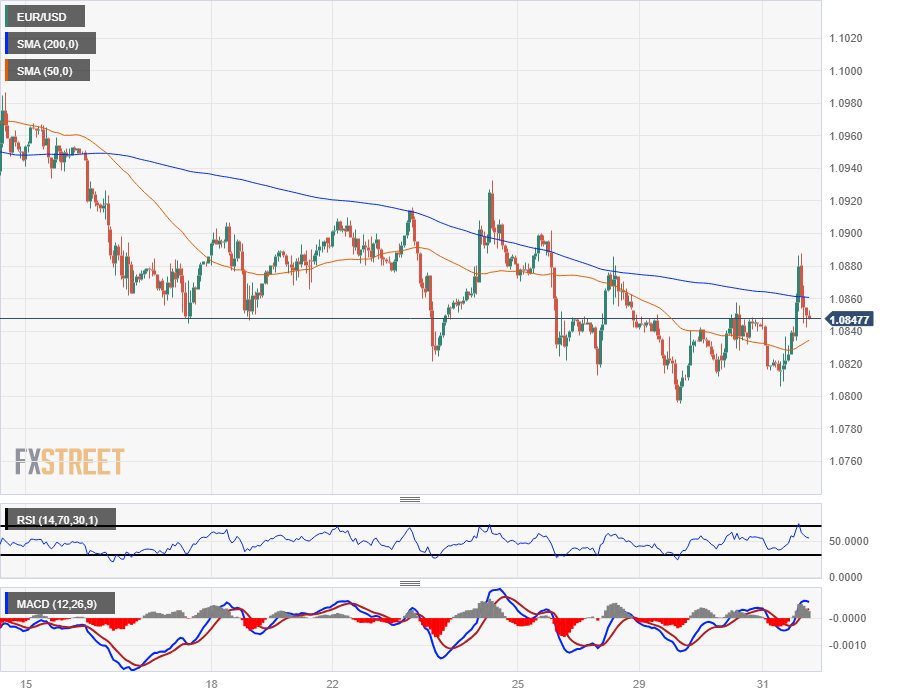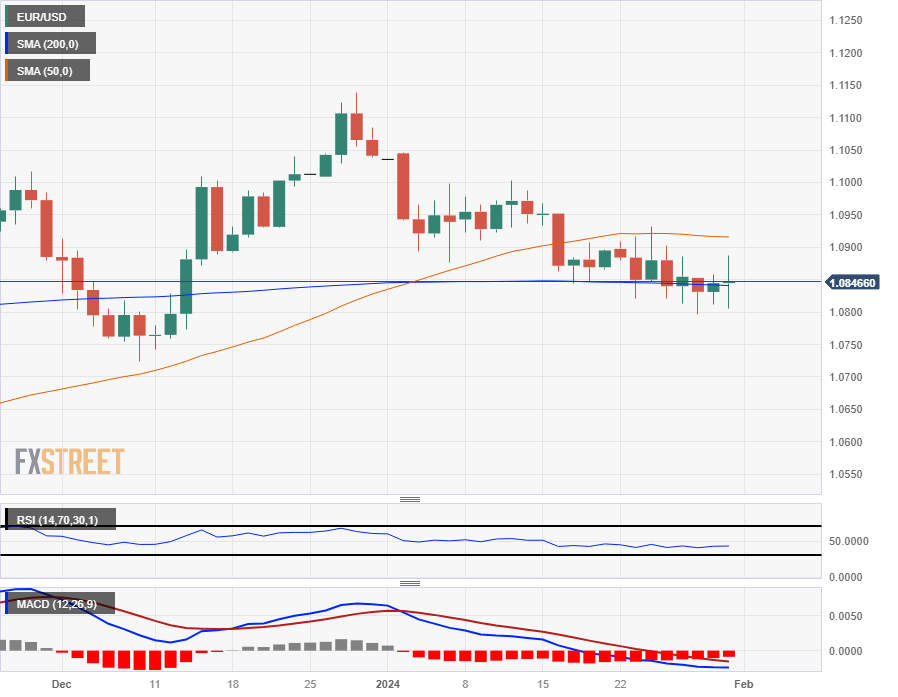- Analytics
- News and Tools
- Market News
- EUR/USD hamstrung near 1.0850 in choppy trade ahead of Fed Powell
EUR/USD hamstrung near 1.0850 in choppy trade ahead of Fed Powell
- EUR/USD saw a hard rally above 1.0880 on ECB rate cut hopes.
- US ADP labor miss drove the pair back into Wednesday’s opening range.
- US Fed head Jerome Powell due at 19:30 GMT after Fed rate call.
EUR/USD saw a hard rally in early Wednesday trading, rising three-quarters of a percent bottom-to-top after misses in German Consumer Price Index (CPI) inflation figures missed the mark, with markets pivoting back into a cautious stance ahead of the Federal Reserve’s (Fed) rate call and following press conference. EUR/USD fell back into the day’s opening bids near 1.0850 as the pair remains stuck in the middle of near-term consolidation.
German Retail Sales backslid early Wednesday, followed by German CPI inflation easing faster than expected, helping to bolster investor sentiment in the midweek that the European Central Bank (ECB) would see the way forward towards a faster pace of rate cuts.
Daily digest market movers: EUR/USD draws into the middle ahead of Powell appearance
- The EUR/USD rallied into 1.0880 after German Retail Sales came in at -1.7% for the year ended December, adding to the previous period’s -2.4% as consumer spending cools off, reinforcing an economic slowdown that will push the ECB towards rate cuts.
- German CPI inflation also declined faster than expected, with annualized German CPI for the year ended January printing at 2.9% versus the forecast 3.3% and the previous period’s 3.7%.
- Pan-European Harmonized Index of Consumer Prices (HICP) figures are due on Thursday.
- European money markets are now pricing in 150 basis points in ECB rate cuts through 2024, up from Tuesday’s swap rate balance of 140 bps.
- Fed chair Jerome Powell due at 19:30 GMT, markets will be straining to find hints of the Fed cutting rates sooner rather than later.
- US ADP Employment Change slumped to 107K in January versus the forecast 145K, declining from the previous month's 158K (revised from 164K).
- US Nonfarm Payroll (NFP) figures due on Friday to cap off the trading week.
Euro price today
The table below shows the percentage change of Euro (EUR) against listed major currencies today. Euro was the strongest against the Australian Dollar.
| USD | EUR | GBP | CAD | AUD | JPY | NZD | CHF | |
| USD | -0.03% | -0.15% | -0.04% | 0.04% | -0.64% | -0.10% | -0.19% | |
| EUR | 0.03% | -0.13% | 0.00% | 0.08% | -0.62% | -0.06% | -0.15% | |
| GBP | 0.16% | 0.14% | 0.13% | 0.20% | -0.47% | 0.06% | -0.01% | |
| CAD | 0.03% | 0.00% | -0.15% | 0.06% | -0.62% | -0.07% | -0.15% | |
| AUD | -0.03% | -0.05% | -0.19% | -0.07% | -0.67% | -0.13% | -0.22% | |
| JPY | 0.64% | 0.60% | 0.46% | 0.60% | 0.70% | 0.52% | 0.45% | |
| NZD | 0.09% | 0.09% | -0.07% | 0.07% | 0.13% | -0.60% | -0.12% | |
| CHF | 0.19% | 0.15% | 0.02% | 0.15% | 0.22% | -0.46% | 0.08% |
The heat map shows percentage changes of major currencies against each other. The base currency is picked from the left column, while the quote currency is picked from the top row. For example, if you pick the Euro from the left column and move along the horizontal line to the Japanese Yen, the percentage change displayed in the box will represent EUR (base)/JPY (quote).
Technical analysis: EUR/USD poised for a run post-Fed
EUR/USD pulled in both direction on Wednesday, sagging early into 1.0806 before rallying above 1.0880 and settling back where it started near 1.0850 as the market awaits central bank appearances.
The 200-hour Simple Moving Average (SMA) remains a key technical barrier, capping off upside momentum near 1.0860. The EUR/USD has cycle familiar levels since the middle of January, but downside pressure has been mounting as swing highs continue to lag lower.
Daily candlesticks have the pair stuck on the low end of a congestion pattern at the 200-day SMA near 1.0850, with topside price action capped by the 50-day SMA just north of 1.0900.
EUR/USD hourly chart
EUR/USD daily chart
Euro FAQs
What is the Euro?
The Euro is the currency for the 20 European Union countries that belong to the Eurozone. It is the second most heavily traded currency in the world behind the US Dollar. In 2022, it accounted for 31% of all foreign exchange transactions, with an average daily turnover of over $2.2 trillion a day.
EUR/USD is the most heavily traded currency pair in the world, accounting for an estimated 30% off all transactions, followed by EUR/JPY (4%), EUR/GBP (3%) and EUR/AUD (2%).
What is the ECB and how does it impact the Euro?
The European Central Bank (ECB) in Frankfurt, Germany, is the reserve bank for the Eurozone. The ECB sets interest rates and manages monetary policy.
The ECB’s primary mandate is to maintain price stability, which means either controlling inflation or stimulating growth. Its primary tool is the raising or lowering of interest rates. Relatively high interest rates – or the expectation of higher rates – will usually benefit the Euro and vice versa.
The ECB Governing Council makes monetary policy decisions at meetings held eight times a year. Decisions are made by heads of the Eurozone national banks and six permanent members, including the President of the ECB, Christine Lagarde.
How does inflation data impact the value of the Euro?
Eurozone inflation data, measured by the Harmonized Index of Consumer Prices (HICP), is an important econometric for the Euro. If inflation rises more than expected, especially if above the ECB’s 2% target, it obliges the ECB to raise interest rates to bring it back under control.
Relatively high interest rates compared to its counterparts will usually benefit the Euro, as it makes the region more attractive as a place for global investors to park their money.
How does economic data influence the value of the Euro?
Data releases gauge the health of the economy and can impact on the Euro. Indicators such as GDP, Manufacturing and Services PMIs, employment, and consumer sentiment surveys can all influence the direction of the single currency.
A strong economy is good for the Euro. Not only does it attract more foreign investment but it may encourage the ECB to put up interest rates, which will directly strengthen the Euro. Otherwise, if economic data is weak, the Euro is likely to fall.
Economic data for the four largest economies in the euro area (Germany, France, Italy and Spain) are especially significant, as they account for 75% of the Eurozone’s economy.
How does the Trade Balance impact the Euro?
Another significant data release for the Euro is the Trade Balance. This indicator measures the difference between what a country earns from its exports and what it spends on imports over a given period.
If a country produces highly sought after exports then its currency will gain in value purely from the extra demand created from foreign buyers seeking to purchase these goods. Therefore, a positive net Trade Balance strengthens a currency and vice versa for a negative balance.
© 2000-2024. All rights reserved.
This site is managed by Teletrade D.J. LLC 2351 LLC 2022 (Euro House, Richmond Hill Road, Kingstown, VC0100, St. Vincent and the Grenadines).
The information on this website is for informational purposes only and does not constitute any investment advice.
The company does not serve or provide services to customers who are residents of the US, Canada, Iran, The Democratic People's Republic of Korea, Yemen and FATF blacklisted countries.
Making transactions on financial markets with marginal financial instruments opens up wide possibilities and allows investors who are willing to take risks to earn high profits, carrying a potentially high risk of losses at the same time. Therefore you should responsibly approach the issue of choosing the appropriate investment strategy, taking the available resources into account, before starting trading.
Use of the information: full or partial use of materials from this website must always be referenced to TeleTrade as the source of information. Use of the materials on the Internet must be accompanied by a hyperlink to teletrade.org. Automatic import of materials and information from this website is prohibited.
Please contact our PR department if you have any questions or need assistance at pr@teletrade.global.















